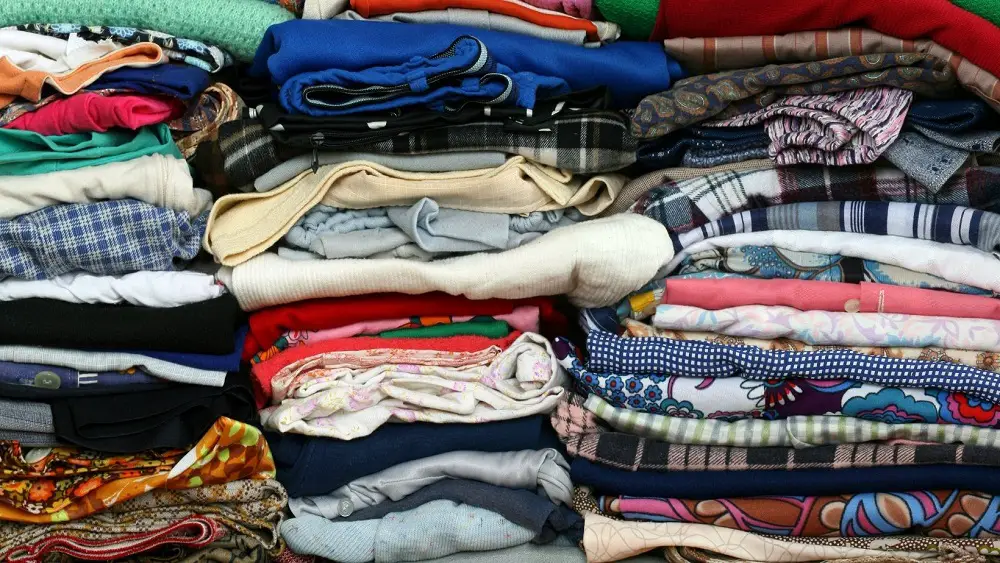We all know that the fashion industry is a non-sustainable form of garment production, and that we all should buy secondhand clothing wherever necessary.
So what about the garments we already have, the ones we wouldn’t want to wear ever again or that we’ve outlived?
Is it possible to recycle clothing? What is the best way to recycle garments if they are able to be recycled?
The United States produces an alarming amount of clothing each year: about 25 billion lbs. Clothes, shoes, accessories, blankets, bedding, and other fabrics are all examples of textiles.
Only 15% of the 25 billion lbs is recycled or repurposed. Moreover, if just 15% of textiles are recycled, the other 85% will be thrown away.
We should all try to avoid fast fashion whenever possible and go for second hand alternatives whenever they’re available.
You could always upcycle unwanted garments into dusting cloths, new outfits, pillowcases, and more if you’re crafty and handy with a sewing machine.
If this doesn’t sound like you, when shopping for clothes, prioritise quality above quantity.
We understand your desire to get the most value for money. That is why fast fashion stores are so successful in the first place; they are inexpensive and, if you are on a small budget, they can be incredibly convenient.
But keep in mind that they’re usually cheap for a reason.
These companies are cutting expenses in other ways that are detrimental to their customers, such as not paying their employees and failing to provide safe and healthy working environments.
Purchasing things of high quality means that they will survive a longer time.
Can I Recycle My Clothes?
Yes! It’s entirely possible to recycle your old and unwanted clothing items and accessories.
However, don’t expect to throw your clothing in a bin near the curb and be done with it. It may take some digging, investigation, and, of course, getting your garments to a store that will really accept them.
Here are some great starting points to recycling your old and unwanted clothing items and accessories:
Donate Them
If you have old or unused clothes that you no longer want, the best thing you can do is to donate them. This is also one of the kindest decisions you can make for the environment and your local community.
If you have any thrift stores in your town, ask them about their donation policy and consider dropping your clothes off there. This will ensure that people on a smaller budget will be able to afford good quality clothing and ensure that they don’t end up straight in landfill.
There are many great apps and websites out there to help you with this. We recommend using the platform Recycle Nation.
Recycle Nation is a website and an application that allows you to identify firms that recycle any type of goods.
You can check for businesses seeking donations of clothing, spectacles, and even electronics.
Return Them
Some shops will either purchase or take donations of your old clothes. Some programmes provide monetary or financial rewards, while others just include a location to drop off worn clothes.
Madewell has earned a reputation for being environmentally conscious by taking used jeans.
You can take a pair of pants to a Madewell store for recycling through the Madewell Denim Recycling programme. If you don’t live near a Madewell, you can have them shipped to you.
Madewell will offer you $20 credit on your next full-price Madewell pants order in exchange.
Other stores with comparable recycling programmes include H&M, North Face, Eileen Fisher, Levi’s, For Days, and Patagonia.
There is also Nike’s Reuse-a-Shoe programme, which takes any brand of old sports footwear.
The remainder of the material is then crushed up and used to build public circuits, parks, lanes, and playgrounds. These businesses normally sell the used fabrics to a company that repurposes or recycles them.
Some shops, such as H&M, donate a portion of their profits to charitable organisations.
Resell Them
If you have clothes that have only been minimally worn or used, you might be able to sell it.
But when it comes to garments, selling fabrics to somebody else who would use them secondhand falls well under the notion of recycling.
Many neighborhood shops and thrift stores will take donations, and some will even pay you money for your items. You can participate in online reseller platforms such as Poshmark or thredUP if you’d prefer to conduct your business electronically.
Is Clothing More Difficult To Dispose Of Than Other Items?

Clothing isn’t always more difficult to dispose of than other goods; it simply requires a little more thought. For instance, if a company is getting rid of clothes, their first thought might be that it can’t be recycled since it has their logo on it, and they don’t want to be giving away labeled things for free
. They may be unaware, however, that there are persons who may take apparel, debrand it, and then reuse it somewhere. This avoids the need for these garments to be disposed of in a landfill or incinerated.
From a consumer standpoint, it’s not as straightforward as tossing garments in with your trash for recycling, but there are options.
Clothing collections by social enterprises such as Clothes Aid, for example, are ideal for customers wishing to get rid of unwanted clothing and donate it to a worthwhile purpose.
What Can We Do To Help?
Firms should undoubtedly lead the way, but people have perhaps the most influence over companies because their demand determines supply.
This is already being seen as apparel businesses shift their focus away from fast fashion and toward sustainable development.
Nevertheless, for the average customer, the easiest thing to do is to attempt to toss aside less clothing, or if it is necessary, to do it in a way that ensures they are put to good use.
Both businesses and individuals have several options for sustainably disposing of clothing, but they are significantly more accessible than most people believe.
Customers also have a variety of options; if you have a great deal of garments to get rid of, you can make a donation it to organisations like Clothes Aid, which offers doorstep pickup, as well as to thrift stores, clothing banks, and even community recycling facilities, since many local authorities now have systems that allow fashion to be recycled.
Some groups even have stores where you can get reimbursed for your unwanted and outdated clothes, which are typically sold to thrift stores in less developed nations.
What Does The Future Of Fast Fashion Look Like?
Unfortunately, until adjustments are implemented, the future does not appear promising.
One brutal reality that isn’t typically considered is that synthetic fiber can take centuries to break down, and given that polyester is among the most commonly used fast fashion textiles, there’s a lot of waste that could be avoided.
If more individuals put their older and unwanted items to better use instead of sending it to the landfill or incinerator, we can help to reduce the amount of polyester manufactured presently.
Fortunately, the industry is becoming more aware of the problem, and it is being addressed.
Final Thoughts
There are plenty of great alternatives to tossing away your old or unwanted clothing items, which will inevitably end up in landfill.
Your options include giving them away to someone you know, donating them to thrift stores, or taking them back to the store you bought them from if they have a recycling program available.
If we all did this instead of bagging them up and tossing them to the curb, the fast fashion industry will become less powerful and lead to positive changes for the planet and the environment. Reduce, reuse and recycle!






